

80
|
MARCH 2017
|
THINK
Nine Safe Sourcing Tips
It is vital for all of us to understand the complex
regulations surrounding the making, testing and shipping
of potentially dangerous lithium-ion battery-powered
products. Our clients rely on us to sell safe products, or
the consequences can be quite serious. So, in a nutshell,
what can we do to prevent being “burned” by poorly made
lithium-ion battery-powered products?
1
Carefully screen
your vendors and
factories and establish
your quality and
safety expectations.
2
Ensure that the
product is properly
designed and use
third-party labs
to review.
3
Verify all raw
materials,
components and
subassemblies used
in the product.
4
Require safety
features such as
regulators, safety
circuits and fuses.
5
Test the nished
products to verify
the factory’s product
safety claims, using a
Nationally Recognized
Test Laboratory
such as UL.
6
Obtain copies
of all testing
and certi cation
veri cations from
your vendors.
7
Ensure that all
packaging, labeling,
instructions
and warnings
are complete
and accurate.
8
Follow all applicable
transportation and
labeling requirements
for lithium
battery products.
9
Consult with industry
experts, such as your
test lab, for guidance.
Askyour factories
to provide
documentation
to verify that the
power banks
will conform
with the proper
safeguards and
standards for
shipping and
transportation
of power banks
underUN38.3.
ion batteries are considered Hazardous
Materials, so we must also focus on
packaging, labeling and transportation to
be compliant with these products.
“We must adhere with all DOT and IATA
rules for packaging, labeling and shipping
of our power banks to ensure that our
products arrive safely and without any
issues so our customers’ orders will not be
delayed for any reason,” says Koenig.
On the testing side, UL’s Schwalb
strongly urges suppliers to “ask your
factories to provide documentation to
verify that the power banks will conform
with the proper safeguards and standards
for shipping and transportation of power
banks under UN 38.3.”
Information, Resources
And Education
e many testing requirements for
lithium-ion batteries, power banks and
other tech products can be confusing.
Where can you learn more about lithium-
ion battery safety and other product
responsibility best practices?
PPAI Website
e PPAI Product Responsibility Action
Group (PRAG) has developed and
published many resources such as
Product Responsibility Best Practices, case
studies, articles, recorded webinars and
presentations, and UL Standard Product
Requirement documents, for members to
access and use. Simply go to the product
responsibility page at
www.ppai.org/inside-ppai to nd these online member
resources. ere are several Product
Responsibility Best Practices speci cally
written on lithium-ion batteries and
power banks available on the PPAI website
and in the PPAI Product Responsibility
Summit binders; see page 81.
PPAI Webinars and Education Sessions
Sign up for PPAI product responsibility
webinars and attend education sessions
on various topics at e PPAI Expo and
Expo East to gain valuable teaching and
















